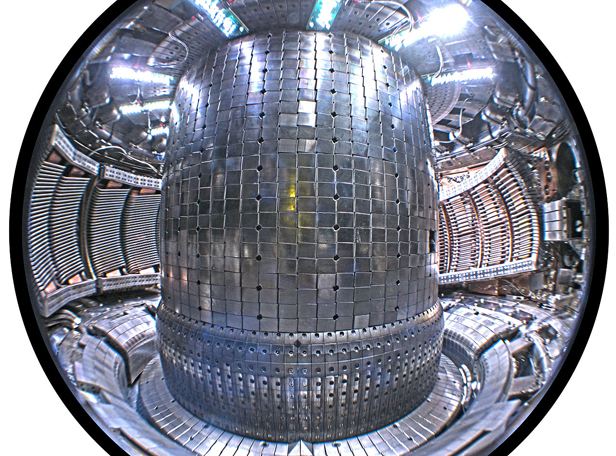Physicists Crack Fusion Mystery

One reason it’s taking decades to develop fusion reactors that can generate electricity is that physicists don’t completely understand what’s going on in the high-temperature plasma inside a reactor. Under certain conditions, the plasma—which is where fusion reactions take place—disappears in under a millisecond.
A new theory developed by researchers at the U.S. Department of Energy’s Princeton Plasma Physics Laboratory (PPPL) explains what happens just before the plasma disappears. The explanation could help engineers design better reactors. And that might help them increase the power output of a reactor, perhaps doubling the electricity they could produce, and making fusion reactors more economical.
Researchers have made a lot of progress on fusion technology—since 1970, the energy produced in experimental fusion reactors has increased by about 12 orders of magnitude, greater than the improvement in processing power in microchips over the same period, says Martin Greenwald, a fusion researcher at MIT. But for all the improvements in fusion research reactors, they still aren’t useful—they don’t produce more energy than they consume, and they can’t be run continuously, both of which would be necessary for a power plant.
The new work, like so much in the realm of fusion research, is a step toward practical fusion power, but by no means does it solve all the problems. Based on experiments, there is a practical limit to how dense the plasma in a reactor can be. Beyond a certain density, the plasma becomes unstable, dissipates its energy, and disappears. Because researchers don’t understand exactly what causes this, it’s difficult to predict exactly when the collapse will happen, so researchers avoid getting close to that limit in experimental reactors.
The Princeton work allows engineers to better predict what will happen in the reactor, potentially allowing them to design reactors that get closer to a theoretically optimum density for the plasma. That, in turn, could increase the amount of power a fusion power plant could generate.
According to the researchers’ theory, islands develop within the plasma that cool off and cause the plasma to disappear. These islands—which are easily identified—could be selectively heated with microwaves, the researchers think, which could keep the plasma stable.
David Gates, a principal research scientist at PPPL and one of the key researchers on the project, says he expects they will be able to test the theory in research reactors this year.
While the theory is plausible, Greenwald says, it doesn’t solve all the problems for reactors. It only explains part of the mechanisms involved in limiting the density of the plasma. And researchers still need to solve many practical problems before optimizing energy density is even an issue, he says.
Solving these problems will require a combination of better theories, more computing power, better algorithms, and big experiments. That’s why researchers still say practical fusion power plants remain decades away.
Keep Reading
Most Popular
Large language models can do jaw-dropping things. But nobody knows exactly why.
And that's a problem. Figuring it out is one of the biggest scientific puzzles of our time and a crucial step towards controlling more powerful future models.
The problem with plug-in hybrids? Their drivers.
Plug-in hybrids are often sold as a transition to EVs, but new data from Europe shows we’re still underestimating the emissions they produce.
How scientists traced a mysterious covid case back to six toilets
When wastewater surveillance turns into a hunt for a single infected individual, the ethics get tricky.
Google DeepMind’s new generative model makes Super Mario–like games from scratch
Genie learns how to control games by watching hours and hours of video. It could help train next-gen robots too.
Stay connected
Get the latest updates from
MIT Technology Review
Discover special offers, top stories, upcoming events, and more.